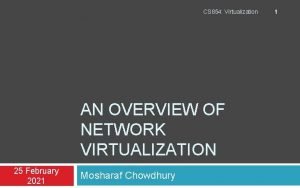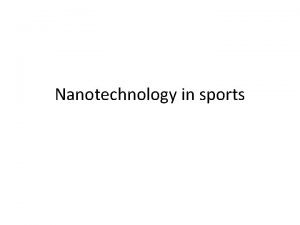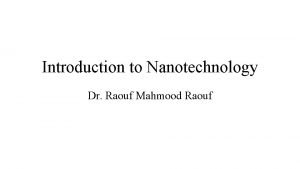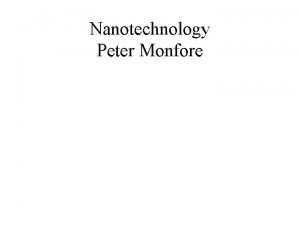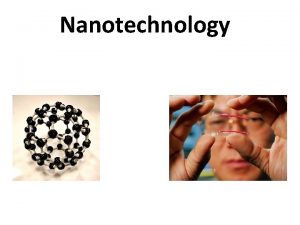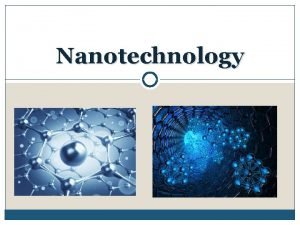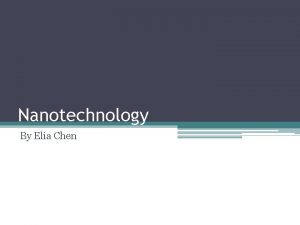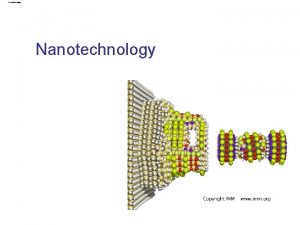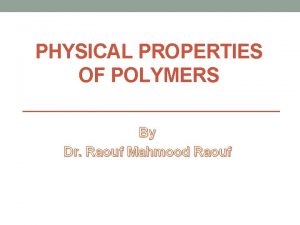Introduction to Nanotechnology Dr Raouf Mahmood Raouf 1










- Slides: 10

Introduction to Nanotechnology Dr. Raouf Mahmood Raouf 1

Topics 1. Introduction 2. What is Nano? 3. Why Nano Technology? 4. Scope of Applications 5. How do properties change at the Nano scale? 6. Current and Future Trends, Research and Applications 2

Introduction Nanomaterials are not new Nanomaterials have been produced and used by humans for hundreds of years. However, the understanding of certain materials as nanostructured materials is relatively recent, made possible by the advent of advanced tools that are capable of resolving information at nanoscale. • We now know that the beautiful ruby red colour of some ancient glass paintings is due to gold and silver nanoparticles trapped in the glass matrix. 3

Introduction • The decorative glaze or metallic film known as ‘luster’, found on some medieval pottery, contains metallic spherical nanoparticles dispersed in a complex way in the glaze, which gives rise to special optical properties. • Carbon black is a nanostructured material that is used in car tyres to increase the life of the tyre and impart black colour. This material was discovered in the 1900 s. 4

Introduction In 1959, the physicist Professor Richard Feynman gave the first illuminating talk on nano technology, which was entitles as: (There’s Plenty of Room at the Bottom). He explored the possibility of “direct manipulation” of the individual atoms to be effective as a more powerful form of ‘synthetic chemistry’. Feynman talked about a number of interesting results of a ‘general ability’ to manipulate matter on an atomic scale. 5

Introduction Scientists have been studying and working with nanoparticles for centuries, but the effectiveness of their work has been hampered by their inability to see the structure of nanoparticles. In recent decades the development of microscopes capable of displaying particles as small as atoms has allowed scientists to see what they are working with. They was particularly interested in the possibility of denser computer circuitry and microscopes that could see things much smaller than is possible using (Scanning Electron Microscope). The IBM research scientists created today’s (atomic force microscope) and (Scanning Tunnelling Microscope), and there are other important examples. Feynman proposed that it could be possible to develop a (general ability) to manipulate things on an atomic scale with a (top → down) approach. 6

Introduction 7

Introduction We can continue with this particular trend of down-scaling until the tools are able to directly manipulate atoms, which will require redesign of the tools periodically, as different forces and effects come into play. Thus, the effect of gravity will decrease, and the effects of surface tension and Van der Waals attraction will be enhanced. 8

Introduction Although Feynman’s talk did not explain the full concept of nano technology, it was K. E. Drexler who envisioned self-replicating (nanobots), i. e. , self-replicating robots at the molecular scale, in Engines of Creation: The Coming Period of Nano Technology in 1986. 9

References • Murday, James F. (2005). Nanotechnology: Hype and Hope in Aerospace Applications. Advanced Materials and Processes. Vol. 163, Issue 12, P. 21. • Rappaport, Tatiana Gabriela (2006). Semiconductors: Nanostructures and applications in spintronics and quantum computation. Vol. 809 issue 1, p. 326. • Wong, H. S. Philip (2006, March). Nanoelectronics – Opportunities and Challenges. International Journal of High Speed Electronics and Systems. Vol. 16, Issue 1, p. 83, 12 p. • Yamaguchi, Tomohiko; Epstein, Irving; Shimomura, Masatsugu; & Kunitake, Toyoki (2005, December). Vol. 15, Issue 4, p. N, 3 p. 10
